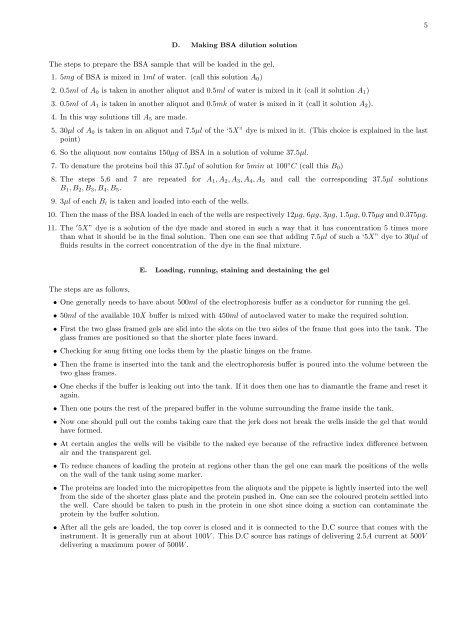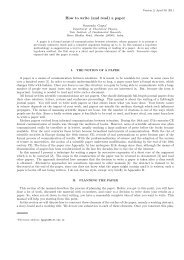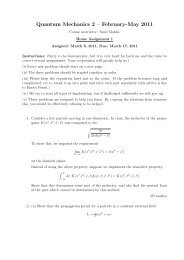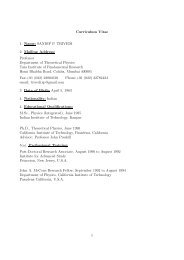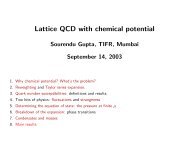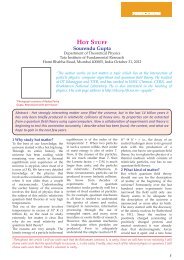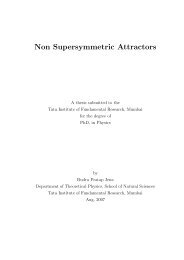A report on an experiment I did of doing electrophoresis with proteins
A report on an experiment I did of doing electrophoresis with proteins
A report on an experiment I did of doing electrophoresis with proteins
You also want an ePaper? Increase the reach of your titles
YUMPU automatically turns print PDFs into web optimized ePapers that Google loves.
5<br />
D. Making BSA diluti<strong>on</strong> soluti<strong>on</strong><br />
The steps to prepare the BSA sample that will be loaded in the gel,<br />
1. 5mg <strong>of</strong> BSA is mixed in 1ml <strong>of</strong> water. (call this soluti<strong>on</strong> A 0 )<br />
2. 0.5ml <strong>of</strong> A 0 is taken in <strong>an</strong>other aliquot <strong>an</strong>d 0.5ml <strong>of</strong> water is mixed in it (call it soluti<strong>on</strong> A 1 )<br />
3. 0.5ml <strong>of</strong> A 1 is taken in <strong>an</strong>other aliquot <strong>an</strong>d 0.5mk <strong>of</strong> water is mixed in it (call it soluti<strong>on</strong> A 2 ).<br />
4. In this way soluti<strong>on</strong>s till A 5 are made.<br />
5. 30µl <strong>of</strong> A 0 is taken in <strong>an</strong> aliquot <strong>an</strong>d 7.5µl <strong>of</strong> the ‘5X” dye is mixed in it. (This choice is explained in the last<br />
point)<br />
6. So the aliquout now c<strong>on</strong>tains 150µg <strong>of</strong> BSA in a soluti<strong>on</strong> <strong>of</strong> volume 37.5µl.<br />
7. To denature the <strong>proteins</strong> boil this 37.5µl <strong>of</strong> soluti<strong>on</strong> for 5min at 100 ◦ C (call this B 0 )<br />
8. The steps 5,6 <strong>an</strong>d 7 are repeated for A 1 , A 2 , A 3 , A 4 , A 5 <strong>an</strong>d call the corresp<strong>on</strong>ding 37.5µl soluti<strong>on</strong>s<br />
B 1 , B 2 , B 3 , B 4 , B 5 .<br />
9. 3µl <strong>of</strong> each B i is taken <strong>an</strong>d loaded into each <strong>of</strong> the wells.<br />
10. Then the mass <strong>of</strong> the BSA loaded in each <strong>of</strong> the wells are respectively 12µg, 6µg, 3µg, 1.5µg, 0.75µg <strong>an</strong>d 0.375µg.<br />
11. The ′ 5X” dye is a soluti<strong>on</strong> <strong>of</strong> the dye made <strong>an</strong>d stored in such a way that it has c<strong>on</strong>centrati<strong>on</strong> 5 times more<br />
th<strong>an</strong> what it should be in the final soluti<strong>on</strong>. Then <strong>on</strong>e c<strong>an</strong> see that adding 7.5µl <strong>of</strong> such a ‘5X” dye to 30µl <strong>of</strong><br />
fluids results in the correct c<strong>on</strong>centrati<strong>on</strong> <strong>of</strong> the dye in the final mixture.<br />
The steps are as follows,<br />
E. Loading, running, staining <strong>an</strong>d destaining the gel<br />
• One generally needs to have about 500ml <strong>of</strong> the <strong>electrophoresis</strong> buffer as a c<strong>on</strong>ductor for running the gel.<br />
• 50ml <strong>of</strong> the available 10X buffer is mixed <strong>with</strong> 450ml <strong>of</strong> autoclaved water to make the required soluti<strong>on</strong>.<br />
• First the two glass framed gels are slid into the slots <strong>on</strong> the two sides <strong>of</strong> the frame that goes into the t<strong>an</strong>k. The<br />
glass frames are positi<strong>on</strong>ed so that the shorter plate faces inward.<br />
• Checking for snug fitting <strong>on</strong>e locks them by the plastic hinges <strong>on</strong> the frame.<br />
• Then the frame is inserted into the t<strong>an</strong>k <strong>an</strong>d the <strong>electrophoresis</strong> buffer is poured into the volume between the<br />
two glass frames.<br />
• One checks if the buffer is leaking out into the t<strong>an</strong>k. If it does then <strong>on</strong>e has to diam<strong>an</strong>tle the frame <strong>an</strong>d reset it<br />
again.<br />
• Then <strong>on</strong>e pours the rest <strong>of</strong> the prepared buffer in the volume surrounding the frame inside the t<strong>an</strong>k.<br />
• Now <strong>on</strong>e should pull out the combs taking care that the jerk does not break the wells inside the gel that would<br />
have formed.<br />
• At certain <strong>an</strong>gles the wells will be visibile to the naked eye because <strong>of</strong> the refractive index difference between<br />
air <strong>an</strong>d the tr<strong>an</strong>sparent gel.<br />
• To reduce ch<strong>an</strong>ces <strong>of</strong> loading the protein at regi<strong>on</strong>s other th<strong>an</strong> the gel <strong>on</strong>e c<strong>an</strong> mark the positi<strong>on</strong>s <strong>of</strong> the wells<br />
<strong>on</strong> the wall <strong>of</strong> the t<strong>an</strong>k using some marker.<br />
• The <strong>proteins</strong> are loaded into the micropipettes from the aliquots <strong>an</strong>d the pippete is lightly inserted into the well<br />
from the side <strong>of</strong> the shorter glass plate <strong>an</strong>d the protein pushed in. One c<strong>an</strong> see the coloured protein settled into<br />
the well. Care should be taken to push in the protein in <strong>on</strong>e shot since <strong>doing</strong> a sucti<strong>on</strong> c<strong>an</strong> c<strong>on</strong>taminate the<br />
protein by the buffer soluti<strong>on</strong>.<br />
• After all the gels are loaded, the top cover is closed <strong>an</strong>d it is c<strong>on</strong>nected to the D.C source that comes <strong>with</strong> the<br />
instrument. It is generally run at about 100V . This D.C source has ratings <strong>of</strong> delivering 2.5A current at 500V<br />
delivering a maximum power <strong>of</strong> 500W .


